TITLE: Dead of Night
RELEASED: 1945
DIRECTORS: Alberto Cavalcanti, Charles Crichton, Basil Dearden and Robert Hamer
CAST: Mervyn Johns, Michael Redgrave, Googie Withers, Basil Radford, Nannton Wayne, Sally Ann Howes, Rowland Culver and Frederick Valk
Review by SELENE PAXTON-BROOKS
Anyone familiar with Ealing Comedies, such as Kind Hearts and Coronets or Passport to Pimlico (both 1949), produced by Ealing Studios between 1947 and 1957, would be amazed at Ealing’s earlier departure to an occult based psychological anthology of five related ghost stories.
Very few horror films were produced around this time, as during the war horror films were banned completely, so the reasons for Ealing to offer us such a haunting and eerie collection of tales can only be wondered upon.
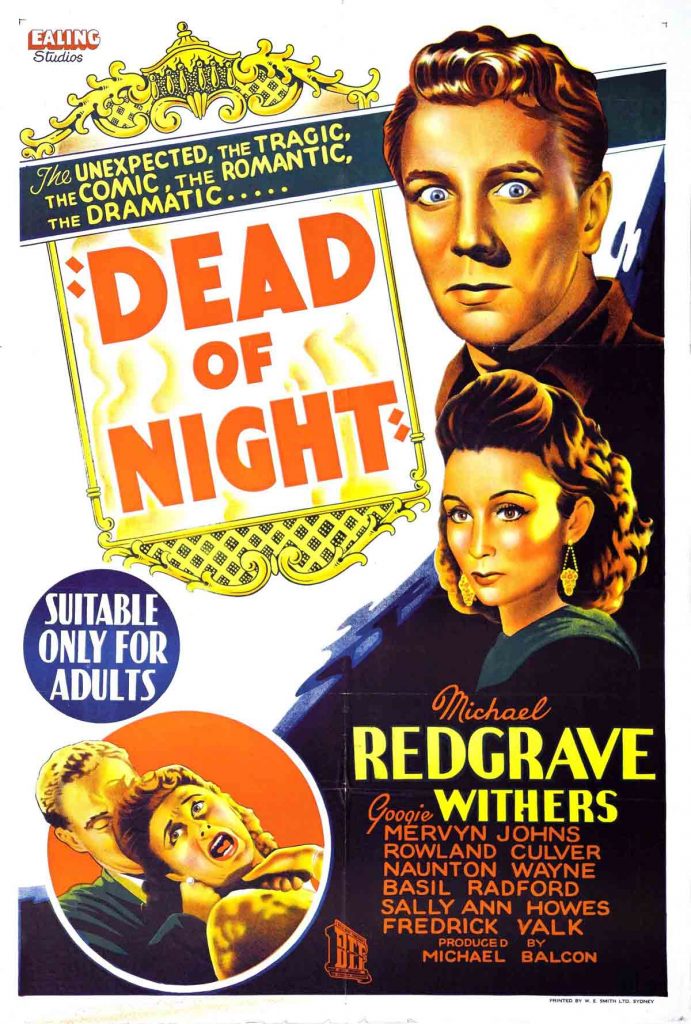
Dead of Night is a collaborative venture by four of Ealing’s resident directors, based around original stories by HG Wells, EF Benson, John Baines and Angus MacPhail (who worked with Alfred Hitchcock), it has been described by Martin Scorsese as one of the scariest films of all time.
To be honest I wouldn’t go that far, but it certainly has an atmosphere that chills, using unusual lighting and creative camera angles, with a distinctive style that has been copied over time very successfully by the likes of Amicus and Hammer.
I remember first seeing this at a film convention in the early 90s and as an illusive and little known feature I couldn’t believe how frightening it was for an early black and white British film.
Dead of Night’s story begins with a jaunty countryside drive to a large manor house, where architect Walter Craig (Mervyn Johns) is introduced to a group of friends.
Craig realises that he has met the party before, telling them that he recognises them all from his dreams. This beginning lures the viewer into the world of the post war British film set, the beautifully clipped accents that tell us that everything is going stiflingly these days, and afternoon tea enjoyed in the comforts of one’s home in front of a roaring fire, we even have a German psychiatrist to boot!
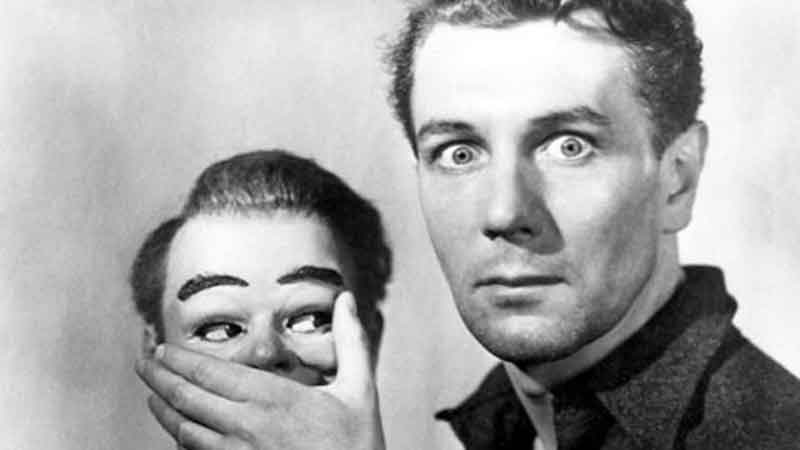
1. ‘Just room for one more inside, Sir’
Mr Granger narrates his own story based on EF Benson’s 1906 short story ‘The Bus- Conductor’, also used by The Twilight Zone in episode 22 (1961) ‘Room for one more, Honey’.
Granger admits to Dr. Von Straaten that something has happened to him that also involves him foreseeing the future. We are then shown a flashback to a racing crash which leaves Granger in hospital close to death, and we find out what has happened by his recollection of the nightmare to his nurse as he proposes marriage! The lighting here is particularly atmospheric, we move from happy banter into dark shadows, informing the viewer that something is not quite right.
Granger’s vision of the hearse driver is fleeting and Granger’s shock confuses us, how did day turn to night so quickly? Granger talks it through with his doctor and we breathe a sigh of relief, of course it was the bump on the head that did it, phew! Until the bus conductor saves his life with those words ‘just room for one inside, sir’.
2. Subconscious thingumajigs (The Christmas Party)
Craig, still convinced that he has been here before, apologises to Sally for frightening her. However, Sally has her own story to tell. We cut to a huge country house in Somerset where a Christmas fancy dress party is in full swing.
Jimmy suggests a game of Sardines and Sally disappears into the winding corridors of the house, and when Jimmy finds her he tells her that the house is haunted by ‘a cold from beyond the grave’. Sally refuses to believe him and they ascend up to the attic where Jimmy continues to tell the story of a girl who murdered her brother.
This story is based on the real murder of Frances Kent who was reputedly murdered by his half sister Constance Kent in 1865, Sally finds Frances crying in the attic and puts him to bed. I think this sequence is beautifully shot, very much in the vein of the film ‘The Innocents‘ (1961) where the darkly lit set controls an atmosphere of trepidation.
The story of Constance Kent had also inspired two famous 19th century writers, Wilkie Collins (The Moonstone – 1868) and Charles Dickens (Mystery of Edwin Drood – 1870) and its inclusion here reminds us that children are not necessarily as naive as Sally is portrayed by the group back at the house.
To end, Sally’s mother appears to whisk her away giving us some light hearted banter to relieve the tension of Sally’s ghostly experience, and to back up Mr Craigs’ foresight.
3. ‘I thought you’d like to look at yourself’
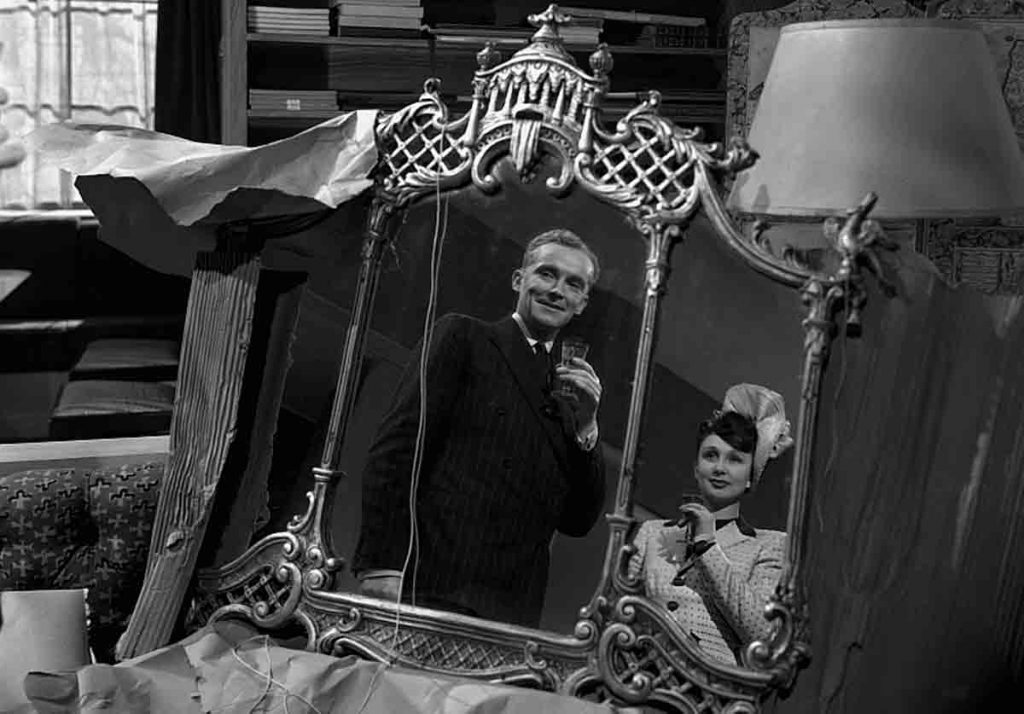
Joan (Googie Withers) admits that she now believes Mr Craigs’ story and asks the doctor to explain her own story. Joan buys a mirror for her fiancé as a present for his birthday, but once hung on the wall all is not as it seems. That evening Peter sees a room in the mirror’s reflection and relays this to Joan at dinner.
The possessed mirror is a well known feature in tales of horror, often used as a portal to another world or a magical item, Amicus also uses it in ‘From Beyond the Grave’ (1974) in a very similar way, and Peter becomes obsessed with the room beyond the mirror.
As time moves on Peter descends even further into madness after the mirror is moved into their new house (personally I would have left it behind, but as Joan says ‘Peter seemed to have completely lost his fear of it’) and Joan goes to visit her mother.
Here she finds out about the history of the mirror and then she realises the mistake she has made by buying it. When Joan returns home Peter has changed; this is quite a harrowing scene but Joan saves the day and the audience breathes another sigh of relief!
4. ‘I wish you where dead, old man!’
This is the penultimate story in the anthology and is used as ‘the calm before the storm’, a little jollity before the final horror of the story. Here we have the Ealing comedy that we know and love, played out very cleverly by Basil Radford and Nannton Wayne, two popular actors who acted together as Charters and Caldicott, the two cricket obsessed Englishmen in Hitchcock’s ‘The Lady Vanishes‘ (1938), to lighten the mood.
Two golfers find themselves in a pickle when they meet a girl called Mary Lee, and as they cannot decide which one of them is to marry her, they play a round of golf for her (she seems very happy about this, which is a little strange in itself!). Parrott cheats to win and on losing Potter admits defeat by walking into the lake, drowning himself.
After his engagement Parrott heads back to the green to play a round of golf and is haunted by the spirit of Potter. Here a lot of light hearted haunting goes on and the old friends are reunited in the club house, where giving up Mary seems acceptable but giving up golf certainly isn’t! The comedy heightens when Potter finds he can’t disappear and is stuck on earth with Parrott who has to remain no less than 6 feet away from him.
As you can imagine this causes a problem, especially on the wedding night! Apparently, in some cuts of the film this whole segment was removed, probably because of its lack of atmospheric value to the film. It ends with the group laughing merrily, commenting on how the horror hasn’t started yet.
5. ‘You don’t know what Hugo is capable of!’
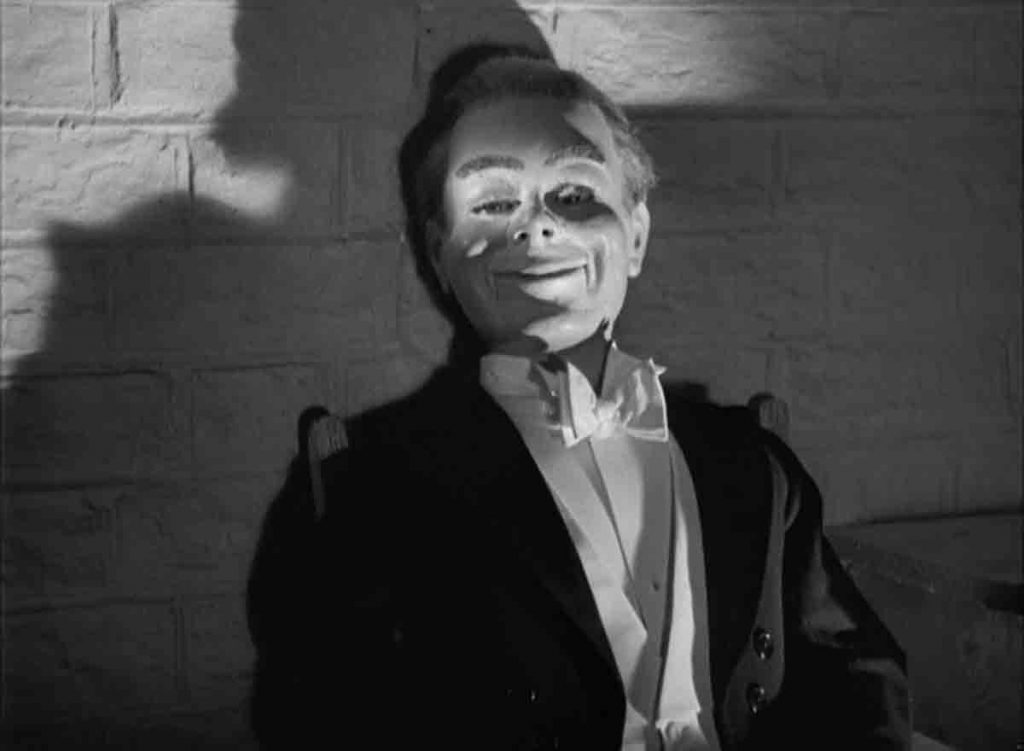
The final story is the truly horrific one! Again using interesting camera angles and contrasting lighting, Dr Von Straaten recalls the tale of Maxwell Frere (Michael Redgrave), ventriloquist. Redgrave and his relationship with the doll, Hugo Fitch, make this the most physiologically disturbing component of the anthology, and Redgrave’s facial expressions make this the most believable and most frightening story of them all. Giving life to inanimate objects seems to stir something deep down and the idea of using a ventriloquist dummy to shock audiences has also been used in the film ‘Magic’ (1978).
On the return to the group of friends we find Mr Craig tells us that it is just starting…
Shadows, weird camera angles and atmospheric use of lighting make this film, and it has been copied subsequently on so many levels. The last few scenes still make my heart flutter and leave images in my head that I would rather forget.
A well worth the watch British classic… but hopefully it shouldn’t give you nightmares!



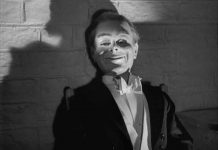
I watched this marvellously scary portmanteau with my father in the early 70s and it scared the living daylights out of me. It will always remain a classic, in my humble opinion, and a work to be studied, especially for its the subtlety of script and the textured, slim lighting; the directors of today should take note! Regards, Paul
I saw this last year at a screening and was blown away. Fantastically inventive and ahead of its time. Almost a British Twilight Zone, 15 years before Rod Serling’s masterpiece.
[…] If you want classic British period horror from the 1940s, you’re better off watching Dead of Night (1945). […]